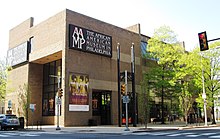This article needs to be updated. (October 2023) |
 African American Museum in Philadelphia | |
| Total population | |
|---|---|
| 1,256,908[1] | |
| Regions with significant populations | |
| North Philadelphia west of Germantown Avenue, Point Breeze in South Philadelphia, West Philadelphia and parts of Southwest Philadelphia[2] | |
| Languages | |
| Philadelphia English, African-American Vernacular English, African languages | |
| Religion | |
| Christianity (Mainly Historically Black Protestant), Islam, Irreligion[3] |
| Part of a series on |
| Ethnicity in Philadelphia |
|---|
|
|
|

| Part of a series on |
| African Americans |
|---|

The history of African Americans or Black Philadelphians in the city of Philadelphia, Pennsylvania has been documented in various sources. People of African descent are currently the largest ethnic group in Philadelphia. Estimates in 2010 by the U.S. Census Bureau documented the total number of people living in Philadelphia who identified as Black or African American at 644,287, or 42.2% of the city's total population.[4]
Originally arriving in the 17th century as enslaved Africans, the population of African Americans in Philadelphia grew during the 18th and 19th centuries to include numerous free Black residents who were active in the abolitionist movement and as conductors in the Underground Railroad. During the 20th and 21st centuries, Black Philadelphians actively campaigned against discrimination and continued to contribute to Philadelphia's cultural, economic and political life as workers, activists, artists, musicians, and politicians.
Between the 1920s and 1940s, North, West, and South Philadelphia saw an increase of the Black population when white flight occurred in Philadelphia.[5] More than 50,000 African immigrants live in the Philadelphia metro area. Most of them are from Ethiopia, Nigeria, Ghana, and Liberia.[6]
- ^ "Philadelphia". 12 December 2023.
- ^ "16 Things to Know: African-American Philadelphia". 8 July 2016.
- ^ "Religious Landscape Study".
- ^ "A City Transformed" (PDF). Philadelphia Research Initiative, 2011. Retrieved March 7, 2021.
- ^ "Black Homeownership Before World War II". 29 March 2023.
- ^ "African | Global Philadelphia". 9 August 2023.
